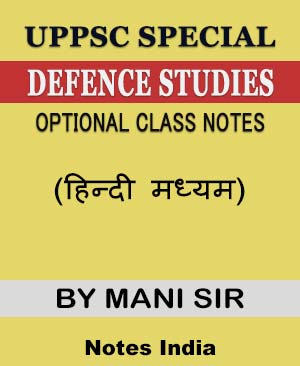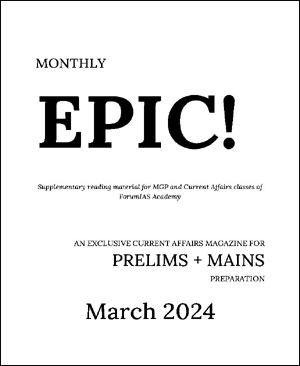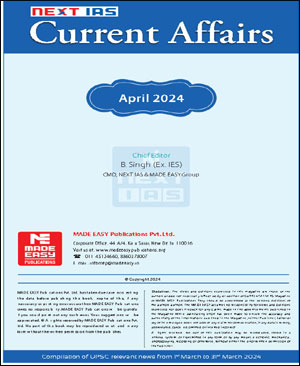DEFENCE STUDIES OPTIONAL CLASS NOTES BY MANI SIR FOR UPPSC EXAM 2017 (HINDI MEDIUM)
Defence studies optional class notes by Mani Sir for UPPSC exam 2017 covered in 2 booklets accordingly UPPSC syllabus details is below:-
DEFENCE STUDIES: PAPER-I - Evolution of Strategic thoughts (Section-A) 1. Concpet and theories of Conflict (a) Origin, perceptions, processes, escalation, goal achivement, etc,of conflicts fn human social relation and its relevance to international conflict. (b) Conflict as War : State behaviour, causes, correlates, domestic sources, glogal structural sources, commencement and termination, negotiation, ecology of warfare etc. (c) Concepts of war and Its relation with politics : Classical thought and trends from Mechiaveli to Nuclear Age. (2) (a) Kautilya's philosophy of war and his strategic contribution. ( ) Suntzu's thoughts on war. b (c) Thoughts of Jomini and Clausewitz on Strategy, Tactics, Logistics, Principles of War and Nature of War War and industrial sociely with reference to the views of Marx Engles. Concepts and 3. 4. Theories of Revolutionary War and Guerrilla Warfare with reference to the views of Lenin, Mao to tung, Che Guevara, Regis Denbray and Giap. 5. Economic Bases of military power : (a) Economics of war. Linkages between commercial, (b) financial, industrial, economic and politic ; military strengths and weaknesses of a nation-state. Arms trace and theory of donor- recipient (c) behaviour. Post-war economy and reconstruction. (d) 6. Theories of Land, Sea and Air warfare : (a) Theories of land warfare with reference to mobile defence, use of tank and machine, warfare and propounded by Liddeli Hast and J.F.C Fuller. Views of A.T. Mahan on the elements of sea power (b) and naval strategy. Continental doctrine of sea power. ( ) Heartland theiroes of Halford (c) d Mackinder. Heartland theories based on National Power. Theories of Air power as propounded (e) (f) by G. Douhet, Mitchell and Alexander de Seversky.
SECTION-B 7. German Concept of total war with reference to the views of Luideadroff ; German strategy in the Machine Age. Military strategy of Allied Powers during the World War II Soviet military 8. 9. strategy with reference to the views of Lenin Trosky, Stalin and V.D Sokolovsky. 10. Concept and theories of deterrence: (a) Concepts and theories of conventional deterrence. Concept and (b) theories of nuclear deterrence with reference to the views of Liddell Hart, Andre Beaufre,Y. Harkavi and Henry Kissinger. Concepts of Disarmament. Concept and theories of Arms Control and 11. 12. Disarmament. Concept and the theories of 'Peace 13. –keeping' and Peace building. Theories of 14. Conflict Resolution, Methods of Conflict Resolution, Gandhian teachniques of Conflict Resolution.
PAPER-II (SECTION-A) 1. Conceptual framework of National Security in the contemporary strategic thinking. Evolution of 2. National Security thinking and problematics. Theories of National Power. De 3. (a) finitive framework of National Power. The impression of Power as a concept. Power pro (b) (c) (d) file of nation stases. Non-Power influence. Elements of National Power Geography, (e) (i) Tangible elements : Population, Extent of Territory. Natural Resources, Industrial Compacity, Financial Capability, Scientific and Technological Capability, Military Capability. Leadership. (ii) Intangible elements : Bureaucratic and Organizational Efficiency. Type of Government, Social and Ethnic cohasiveness, National, Character and Requtation, National, Morale, Public Support. Concept and models of 4. International Security. Conceptual frame work of International Security during the Cold War and (i) Post Cold War Periods. Balance of Power Collective Security Collective Defence Non- (ii) (iii) (iv) (v) Alignment. . Concept and theories of conventional and nuclear deterrence. Arms proliferation (5) 6. (i) as constraint to National. Regional and International Security. Prospects for Arms control. (ii) 7. International Terrorism : 8. Insurgency and Counter- Insurgency: Concept and dimensions. Concepts and dimensions. Defence and Domestic policies. 9. Co-relation between Foreign, 10. Historical Legacy, Geo-political and Geo Strategical consideration of India's Security.
SECTION-B 11. NATIONAL SECURITY PROBLEMATICS AND INDIA QUEST FOR SECURITY : (a) India is the world strategic arena; Contemporary trends. India's quest for security Vis-avis Pakistan (till-date); (b) Pakistan's conventional nuclear and missile programmes and their impact no India defence, India's options. India- China boundary dispute; Positions and Polemics: efforts for the settlement of (c) boundary dispute; framework of Cooperative Security between India and China. India's mutuality (d) of strategic and other interests with Bangladesh, Nepal, Bhutan, Mayanmar, Srilanka, Maldives and Afganistan. Role of extra- regional power in the Post-Cold War South Asian strategic milieu and (e) India's security considerations. Need of Con (f) fidence and Security Building Measures' for India and its South Asia neighbours. 12. SCIENCE, TECHNOLOGY AND INDIA'S SECURITY : (a) India's scientific and technological base for National Defence. Need for India's integrated science policy. (b) (c) India's defence industrialization and achievements. Indian's Research and Development (d) (R&D) 13. INDIA'S NUCLEAR POLICY AND OPTIONS : (a) (b) India's need for Nuclear power. India's Nuclear breakthroughs. India's nuclear options in a nuclearised world. (c) (14) INDIAN OCEAN AND INDIA'S SECURITY CONSIDERATIONS (a) : Strategic mileu in and around the Indian Ocean region India's security problems in relation to the Indian Ocean region Indian's maritime (b) (c) security and its needs for naval power projections; 15. India's over-all security perspectives and defence preparedness. 16. INTERNATIONAL SECURITY OF INDIA (a) : Harmful internal; threats and challenges-diminution of social and ethnic cohesiveness. communalism, linguistic differences; regionalism: rise of ethno nationalism. poor governability and political instability, corruption in the various walks of National life overpopulations and ethnic migration across the borders rising but frustrated expectations of people at the root of insecurity; ecological imbalances and economic problems. Low Intensity Con (b) flicts (LIC) in India with special reference to Jammu & Kashmir and North-East region. Identi (c) fication of the problems of Internal Security and conditions for the use of military; pros and cons. imperatives of comprehensive National Security-Strategy.
Lorem ipsum dolor sit amet, consetetur sadipscing elitr, sed diam nonumy eirmod tempor invidunt ut labore et dolore magna aliquyam erat, sed diam voluptua. At vero eos et accusam et justo duo dolores et ea rebum. Stet clita kasd gubergren, no sea takimata sanctus est Lorem ipsum dolor sit amet. Lorem ipsum dolor sit amet, consetetur sadipscing elitr, sed diam nonumy eirmod tempor invidunt ut labore et dolore magna aliquyam erat, sed diam voluptua.
At vero eos et accusam et justo duo dolores et ea rebum. Stet clita kasd gubergren, no sea takimata sanctus est Lorem ipsum dolor sit amet. Lorem ipsum dolor sit amet, consetetur sadipscing elitr.
Sed diam nonumy eirmod tempor invidunt ut labore et dolore magna aliquyam erat, sed diam voluptua. At vero eos et accusam et justo duo dolores et ea rebum. Stet clita kasd gubergren, no sea takimata sanctus est Lorem ipsum dolor sit amet.
Related Products
Vision Ias - Modern Indian History - 7 Year PYQ Trend Analys
Lorem ipsum dolor sit amet, consetetur sadipscing elitr, sed diam nonumy eirmod tempor invidunt ut l..
Vision Ias - Geography - 7 Year PYQ Trend Analysis - GS Prel
Lorem ipsum dolor sit amet, consetetur sadipscing elitr, sed diam nonumy eirmod tempor invidunt ut l..
Vision Ias - Economics - 7 Year PYQ Trend Analysis - GS Prel
Lorem ipsum dolor sit amet, consetetur sadipscing elitr, sed diam nonumy eirmod tempor invidunt ut l..
Vision Ias - Ancient History Medieval History & Culture -
Lorem ipsum dolor sit amet, consetetur sadipscing elitr, sed diam nonumy eirmod tempor invidunt ut l..
Forum Ias - Monthly Prelims + Mains Epic - Current Affairs -
Lorem ipsum dolor sit amet, consetetur sadipscing elitr, sed diam nonumy eirmod tempor invidunt ut l..
Next Ias - Monthly Magazine - Current Affairs April 2024 - E
Lorem ipsum dolor sit amet, consetetur sadipscing elitr, sed diam nonumy eirmod tempor invidunt ut l..
Next Ias - Current Affairs For Prelims (CAP) - Miscellaneous
Lorem ipsum dolor sit amet, consetetur sadipscing elitr, sed diam nonumy eirmod tempor invidunt ut l..
Next Ias - Current Affairs For Prelims (CAP) - Environment -
Lorem ipsum dolor sit amet, consetetur sadipscing elitr, sed diam nonumy eirmod tempor invidunt ut l..
Unacademy Ias - Mrunal Economy QEP3 - Batch Mains QEP - Engl
Lorem ipsum dolor sit amet, consetetur sadipscing elitr, sed diam nonumy eirmod tempor invidunt ut l..
Drishti Ias - Current Affairs Consolidation Monthly Magazine
Lorem ipsum dolor sit amet, consetetur sadipscing elitr, sed diam nonumy eirmod tempor invidunt ut l..











